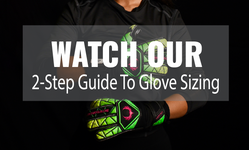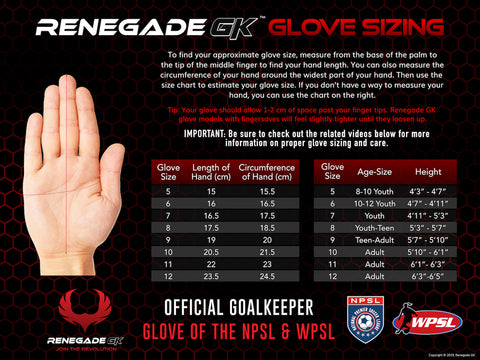Have you ever heard the phrase that goalkeepers are either crazy or genius? Let’s face it, it takes a special person to be a goalkeeper. Knowing that you are potentially sacrificing your body for the 10 in front of you over the next 90 minutes doesn’t usually sit well with most players. Being a soccer goalie takes more responsibility than any other player on the field. You are the last line of defense and mistakes at our position are impossible to overcome! Balancing emotions, technique, and pure insanity are just a few of the elements of what makes goalkeeping such a unique position.
While balancing the emotional, psychological, and physical aspects of goalkeeping is certainly critical, it shouldn’t go without notice that the gear you wear is close to the top of the list in terms of impact on your play. It is important that we as goalkeepers are choosing the right pair of gloves to allow us to perform at our best. Though your gloves may be a simple piece of equipment that gets taken in and out of your bag they are as essential and as important as the cleats on your feet.
So how do you know if your new goalkeeper gloves are still good? First, you need to know what goalie gloves are composed of and their specific functions.
-
Backhand - The backhand is material that has been padded to help safeguard the hand when punching the ball. The quality depends on the value of the gloves and specifically what type of latex has been used. Some may look appealing (colorful/branded) and be costly, but still, always go with the gloves that offer the most value for your money. Check out our backhand options!

-
Palm - This is where you should look for the details. Keeper gloves with good grip typically cost the big bucks. But why? The unique blend of latex on the palms of gloves determines the latex tackiness and also the blend of materials used in production. The lesser amounts of plastic used in the latex construction process the softer the latex will be when ultimately being used on the gloves. This is why gloves with a more durable palm like Rough Profile, also sometimes called a Hard Ground glove tends to last longer while it does sacrifice a bit of grip. Palm latex such as Contact or Giga have been produced for optimum tackiness, yet, will not generally hold up as long due to their lesser blend of plastics in the latex. Typically you will find goalkeeper glove palms comes in three different types: Smooth, Texture and Dimpled. Though they each have specific uses it always boils down to how you use them and when to use them such as field type and climate conditions. For match use, smooth is typically the best option while Dimpled or Textured tend to hold up better when used for training.

- Finger Protection - If you choose to go the route of finger protection then this is a keeper’s biggest advantage during play, and a critical aspect during shot stopping especially. Finger protection gloves typically contain multiple layers of cloth lining located in the finger construction in order to protect the fingers from the fingersave spines. The fit of your gloves will definitely depend on the goalie's preference, some may like a stiffer or loose, more pliable fit to allow finger mobility. For a closer look at fingersave protection, options check out our in-depth video on the different types of fingersave spines currently being circulated by gloves brands:
- Closure - This refers to the way a keeper actually puts the gloves on and off of their hands, and how it is secured at the wrist. There are roughly 4 different aspects and/or types of goalie glove closures: hook and loop, puller, puller tab, and the bandage strap. Hook and loop closures are the most common and feature an elastic, adjustable flap that can be used to tighten and loosen the glove. V-notch closures have a vented entry to help keep your hands cool and dry. Bandage closures are primarily made of elastic or stiff dumbex latex that wraps firmly around the wrist. It also provides the most supportive fit and enhances the protection offered in the glove.
We know this post scratches but the surface of glove anatomy but we hope it serves as a starting point for you ahead of your next big purchase. Always remember that when purchasing gloves the right fit should be your priority as opposed to the brand of gloves. Think of it like a pair of tennis shoes, or even clothes; some brands just don't fit certain individuals right. This is often true in your keeper gloves. Now that you know the 4 primary aspects to look for when choosing a pair of goalie gloves, it’s time to shop around the gloves for your next match.
If you still have questions or want to know more please don't hesitate to reach out to one of our GK support team members and they will help you narrow down your choices. Contact us here.











